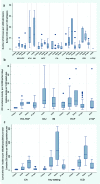Global burden of Clostridium difficile infections: a systematic review and meta-analysis
- PMID: 30603078
- PMCID: PMC6304170
- DOI: 10.7189/jogh.09.010407
Global burden of Clostridium difficile infections: a systematic review and meta-analysis
Abstract
Background: Clostridium difficile is a leading cause of morbidity and mortality in several countries. However, there are limited evidence characterizing its role as a global public health problem. We conducted a systematic review to provide a comprehensive overview of C. difficile infections (CDI) rates.
Methods: Seven databases were searched (January 2016) to identify studies and surveillance reports published between 2005 and 2015 reporting CDI incidence rates. CDI incidence rates for health care facility-associated (HCF), hospital onset-health care facility-associated, medical or general intensive care unit (ICU), internal medicine (IM), long-term care facility (LTCF), and community-associated (CA) were extracted and standardized. Meta-analysis was conducted using a random effects model.
Results: 229 publications, with data from 41 countries, were included. The overall rate of HCF-CDI was 2.24 (95% confidence interval CI = 1.66-3.03) per 1000 admissions/y and 3.54 (95%CI = 3.19-3.92) per 10 000 patient-days/y. Estimated rates for CDI with onset in ICU or IM wards were 11.08 (95%CI = 7.19-17.08) and 10.80 (95%CI = 3.15-37.06) per 1000 admission/y, respectively. Rates for CA-CDI were lower: 0.55 (95%CI = 0.13-2.37) per 1000 admissions/y. CDI rates were generally higher in North America and among the elderly but similar rates were identified in other regions and age groups.
Conclusions: Our review highlights the widespread burden of disease of C. difficile, evidence gaps, and the need for sustainable surveillance of CDI in the health care setting and the community.
Conflict of interest statement
Competing interests: MHK is an employee of Sanofi Pasteur. EB, TS, CL, IL, JB, CW have no relevant conflict of interest to declare. HC and HN received grants from Sanofi Pasteur. HC is the Editor-in-Chief of the Journal of Global Health. All authors have completed the ICMJE uniform disclosure form at http://www.icmje.org/coi_disclosure.pdf (available upon request from the corresponding author), and declare no other conflicts of interest.
Figures


References
-
- Davies KA, Longshaw CM, Davis GL, Bouza E, Barbut F, Barna Z, et al. Underdiagnosis of Clostridium difficile across Europe: the European, multicentre, prospective, biannual, point-prevalence study of Clostridium difficile infection in hospitalised patients with diarrhoea (EUCLID). Lancet Infect Dis. 2014;14:1208–19. doi: 10.1016/S1473-3099(14)70991-0. - DOI - PubMed
Publication types
MeSH terms
LinkOut - more resources
Full Text Sources
Medical
